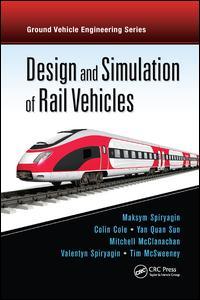Design and Simulation of Rail Vehicles Ground Vehicle Engineering Ground Vehicle Engineering Series
Auteurs : Spiryagin Maksym, Cole Colin, Sun Yan Quan, McClanachan Mitchell, Spiryagin Valentyn, McSweeney Tim

Keep Up with Advancements in the Field of Rail Vehicle Design
A thorough understanding of the issues that affect dynamic performance, as well as more inventive methods for controlling rail vehicle dynamics, is needed to meet the demands for safer rail vehicles with higher speed and loads. Design and Simulation of Rail Vehicles examines the field of rail vehicle design, maintenance, and modification, as well as performance issues related to these types of vehicles. This text analyzes rail vehicle design issues and dynamic responses, describes the design and features of rail vehicles, and introduces methods that address the operational conditions of this complex system.
Progresses from Basic Concepts and Terminology to Detailed Explanations and Techniques
Focused on both non-powered and powered rail vehicles?freight and passenger rolling stock, locomotives, and self-powered vehicles used for public transport?this book introduces the problems involved in designing and modeling all types of rail vehicles. It explores the applications of vehicle dynamics, train operations, and track infrastructure maintenance. It introduces the fundamentals of locomotive design, multibody dynamics, and longitudinal train dynamics, and discusses co-simulation techniques. It also highlights recent advances in rail vehicle design, and contains applicable standards and acceptance tests from around the world.
? Includes multidisciplinary simulation approaches
? Contains an understanding of rail vehicle design and simulation techniques
? Establishes the connection between theory and many simulation examples
? Presents simple to advanced rail vehicle design and simulation methodologies
Design and Simulation of Rail Vehicles
Introduction. Unpowered Rail Vehicle Design. Design of Locomotives. General Modelling Techniques. Multibody Dynamics. Longitudinal Train Dynamics. Rail Vehicle–Track Interaction Dynamics. Co-Simulation and Its Application. Advanced Simulation Methodologies. Conclusion. Index.
Maksym Spiryagin works as a chief investigator at the Centre for Railway Engineering at Central Queensland University (CQU), Australia. His current research interests are rail vehicle dynamics, locomotive traction, mechatronics, and real-time and software-enabled control systems. He received his PhD in the field of railway transport in 2004 at the East Ukrainian National University. His research focused on rail vehicle design and the development of locomotive traction, real-time models, and vehicle mechatronic systems. He has more than 80 scientific publications and is listed as one of the inventors of 20 patents.
Colin Cole is the director of the Centre for Railway Engineering at Central Queensland University (CQU), Australia. He is also the research program leader for the Engineering and Safety Program of the Australian Cooperative Research Centre for Rail Innovation. His PhD was in longitudinal train dynamics. His rail industry experience includes track maintenance, rolling stock and vehicle dynamics, simulation, and the development of on-board devices. His current research interests are train and wagon dynamics, simulation, and train control technologies. He has published 72 papers and one book chapter, and has two patents.
Yan Quan Sun works as a senior research engineer at the Centre for Railway Engineering at Central Queensland University (CQU), Australia. His current research interests include rail vehicle dynamics, longitudinal train dynamics, rail vehicle–track interaction dynamics, and rail–track and bridge dynamics. He came to Australia in 1998 and received his PhD in the field of railway transport in 2002 at CQU. He has published more than 70 scientific and academic papers.
Mitchell McClanachan is a mechanical engineer and has been involved in railway research projects for individual railway companies and cooperative rail research agencies at the Centre for Railway
Date de parution : 11-2017
15.6x23.4 cm
Date de parution : 05-2014
Ouvrage de 337 p.
15.6x23.4 cm
Thèmes de Design and Simulation of Rail Vehicles :
Mots-clés :
Rail Vehicles; Wagon Body; wagon; Draft Gear; locomotive; Brake Pipe; rail vehicle dynamics; Wheel Rail Contact; longitudinal train dynamics; Bogie Frames; multibody simulation; Braking Force; co-simulation; Multibody Model; Vehicle Car Body; Secondary Suspension; Triple Valve; Brake Cylinders; Rolling Stock; Pneumatic Braking; Traction Control System; Heavy Haul; Rail Vehicle Design; Co-simulation Process; Wagon Connection; Wagon Connection Model; Vertical Wheel Force; Draft Gear Model; Heavy Haul Trains
